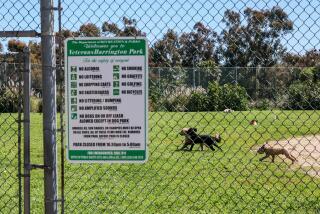Scholars’ Collars
- Share via
When John Taylor’s mother urged him to get a guide dog, he refused, saying he didn’t need one.
Before Halloween, Taylor, 36, who is legally blind, knocked over a chocolate display at a supermarket. Another time, he was walking on a sidewalk and fell into a construction trench that he hadn’t detected with his cane.
The mishaps--humiliating and humbling--forced the Saugus resident to change his mind. This Sunday, Taylor and his new teammate, a 2-year-old black Labrador named Ulysses, will graduate from a 28-day residential course at Guide Dogs of America in Sylmar.
Taylor, initially unsure about trusting a dog to help him navigate, has been won over by Ulysses. It didn’t take long. On the second day of the training course, Taylor, firmly holding the dog’s harness, signaled Ulysses to cross 1st Street in Burbank. Taylor knew pedestrians had a green light, but the dog wouldn’t budge. Instead, Ulysses pulled back a step. The next instant, a car screeched around the corner, running the light.
“Without this dog, John Taylor would not be here now,” Taylor said soberly. “I was on Cloud 9--I can trust this dog totally 100%.”
At the nearly 8-acre facility of Guide Dogs of America, instructors breed and train dogs to obey commands, ignore tempting distractions and anticipate hazards for their owners, such as low-hanging limbs or potholes. The training also includes something Ulysses demonstrated: Intelligent disobedience, or the ability to disobey when the command will endanger his owner.
On the campus, which includes a dormitory, instructors also work with the blind, teaching them how to use, trust and tend the dogs (70% are Labrador retrievers, 15% are golden retrievers and 15% are German shepherds).
“With guide dogs, vision becomes the palm of your left hand, which holds the harness,” said Steve C. Burkman, director of training. “Learning to use a guide dog is very much an art, a skill.”
But the payoff makes it worthwhile, guide dog owners say. How? “Freedom. Freedom,” said Janet Perry, 53, of Murrieta. “Independence. Security. . . . It means being able to walk out the door and not having to call people to get somewhere.” Perry, a member of Taylor’s class, is working with her second guide dog, a German shepherd named Vanish. (Guide dogs usually retire after about eight years.) She found that with a dog, she no longer felt like a “sitting duck at night. With a dog, nobody is going to mess with me.”
She also realized that a guide dog allowed her to interact more freely with strangers. “When you have a cane, people are standoffish. When you have a dog, the dog breaks that barrier; people who wouldn’t normally approach will come up to you.”
Most of the dogs--though not Perry’s Vanish, which was donated by an outside breeder--are bred at the school. When the puppies are 8 weeks old, the school places them in the care of volunteer puppy-raisers, people living anywhere from San Luis Obispo to San Diego who care for the animals until they are about 16 months old.
The puppy-raiser’s task is to teach their charges basic obedience and to familiarize them with various experiences, such as riding in a car and going into stores. For their excursions, the puppies wear bright yellow capes that read: “I’m in training.”
The puppy-raisers’ job is difficult because, after tending their charges for almost two years, they return them to the school. Brett Loutensock of Burbank initially felt overwhelmed with sadness at the thought of relinquishing his foster puppy, a black Labrador named Tatum. But then he met a young blind man at a Montgomery Ward store who told him how his guide dog, a yellow Labrador named Capt. Hook, was crucial to his leading a normal life.
“Every qualm I had about giving up my dog vanished on the spot,” Loutensock said as Tatum wagged her tail. “I love her to death but I could give her up for that purpose.”
Tatum and the other puppies are periodically checked by the school, which evaluates their health as well as their disposition, screening out dogs that show, for instance, aggressive behavior, hip problems or an inability to focus. Only completely sound dogs will be accepted for further training at the school.
(About 50% are allowed to return to school for the final six months of training that transforms them into guide dogs, said Thom Brunley, a senior kennel technician. The rejects are offered to their puppy-raisers or given away to people on a waiting list for school washouts, which are highly trained compared to most pets.)
Breeding, raising and training costs the private, nonprofit school about $25,000 for each dog, officials say. But the animals are given free to their blind owners, who must be at least 80% visually impaired and at least 16 years old. In assessing applicants, school officials also look for candidates who are mobile--not those who spend their days at home.
The program was founded in 1948 by the International Assn. of Machinists and Aerospace Workers after one of its members, 57-year-old Joseph Jones Jr., was told he was too old to qualify for a guide dog. Jones went to his union, which set up its own program. So today, the school has no upper age limit. Most of the dogs are given to Californians and there is a waiting list of about six months.
The school, which is funded by grants and donations, hosts benefits such as the L.A. Dog Jog on May 18 to help balance its budget. The event, on the Veterans Administration grounds in West Los Angeles beginning at 8 a.m., offers races for people and their pooches, as well as silly pet tricks. The school also opens it doors to the public for tours twice weekly, selling T-shirts and hats at the conclusion of the tours.
School officials like to tell the story of one recent graduate who was walking with her dog down a street in Carson City, Nev., when the dog suddenly pulled his owner into a ditch. A person ran up, asking the shaken owner: “Are you OK? You almost got killed by the trailer that fishtailed, skidding across the road.”
Such acts--though maybe not always as dramatic--happen all the time, said Andi Krusoe, admissions and graduate services manager. “A lot of times, people don’t know what their dogs do--it’s very smooth. Guide dogs are everyday heroes.”
(BEGIN TEXT OF INFOBOX / INFOGRAPHIC)
The Beat
Today’s centerpiece focuses on Guide Dogs of America, a nonprofit group that trains dogs for the visually impaired and teaches people how to use and tend to the dogs. For more information, call (818) 362-5834. For details about the L.A. Dog Jog, a May 18 fund-raiser, call (310) 828-4123.
More to Read
Sign up for Essential California
The most important California stories and recommendations in your inbox every morning.
You may occasionally receive promotional content from the Los Angeles Times.










